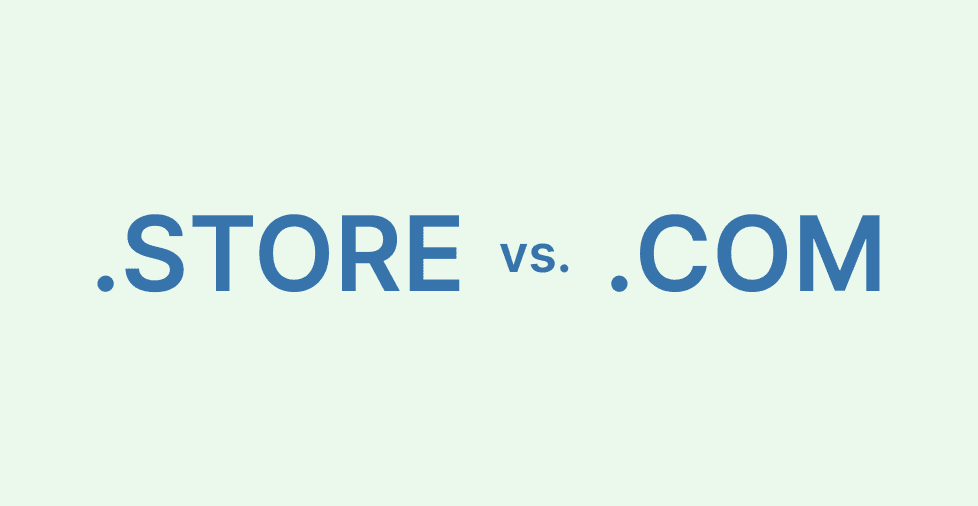Key takeaways:
- Originally intended for businesses, .com has become the default TLD for virtually any type of website.
- The .store domain was created to fill the need for an industry-specific TLD, which .com didn’t provide.
- A .store domain is ideal if your goal is to clearly communicate that you’re selling products or services, but .com is better suited if you’re looking for a broader reach. Ultimately, it all depends on your brand’s needs and objectives.
A website is often your brand’s first impression. Before you design or launch, choosing the right top-level domain (TLD) sets the foundation for how your site is perceived.
But before you even start designing your site or selecting a website builder, there’s one critical decision to make: choosing the right top-level domain (TLD). The domain extension you select, whether it’s the universal .com or the more niche .store, can significantly impact how your brand is perceived.
This article will guide you through a comprehensive comparison of the .com and .store TLDs, helping you understand each domain extension’s unique strengths and weaknesses.
Whether you’re launching a website from scratch or considering a rebrand, we’ll help you choose the domain extension that best aligns with your brand’s goals and target audience.
What is a top-level domain?
Before you begin your journey of establishing your online presence, it’s important to understand the term: top-level domain.
A top-level domain (TLD) is the part of your web address that comes after the dot. It’s what visitors type into their browser to reach your site, like example.com.
TLDs tell search engines and visitors what your website is about. Here are a few of the earliest TLDs and what they mean:
- .com. Short for commercial, this is the most globally recognized and used top-level domain today. Initially, they were intended to determine commercial businesses and were exclusive to commercial entities. However, restrictions were lifted and the .com became the most generic top-level domain as the internet grew.
- .net. The .net TLD was originally intended for network technology companies, such as infrastructures or internet service providers (ISPs).
- .edu. This TLD is reserved for educational institutions, including colleges, universities, and secondary schools.
- .org. Originally created for nonprofit organizations, .org was first used by Mitre Corporation (Mitre.org) and has since become popular with both nonprofit and for-profit groups.
- .mil. Created specifically for the American military, this domain is restricted to American military branches. Other countries’ militaries must use their country codes to distinguish themselves.
- .gov. Short for “government”, this TLD is meant for government agencies, programs, cities, states, and towns.
Evolution of domain extensions: From .com to .store
TLD options have increased significantly since the early days of the internet. Choices were once limited to a handful of generic TLDs, such as .com, .org, and .net. However, as the internet expanded and businesses became more diverse, there was a growing need for industry-specific TLDs.
The .store TLD, which was introduced in 2016, was a direct result of this trend. It was designed specifically for businesses focused on selling products or services online.
| Factor | .com | .store |
| Popularity and trust | Established and widely recognized, associated with any website | More niche, created for e-commerce, but not as widely recognized |
| Target audience | Any type of website, broad audience | Primarily e-commerce sites, businesses selling products |
| SEO impact | Doesn’t directly affect SEO, but competition is higher due to popularity | Doesn’t directly affect SEO, but offers a unique identity for eCommerce sites |
| Availability | More .com domains are taken, making it harder to find available options; more likely to come across a premium .com domain due to its popularity | Easier to find available domains, but more niche |
| Costs | Lower cost (typically cost around $10-15 per year); more expensive premium .com domains available | Higher cost (typically cost around $30-80 per year) |
| Brand Perception | Trusted by users, universally recognized | May create a distinct identity but could be unfamiliar to some users |
| Marketing Potential | Familiar to consumers, great for general marketing | Unique and stands out, especially for e-commerce, but may require more effort to build recognition |
The importance of choosing the right TLD
Your TLD is key to your website’s success. It helps define your brand and sets user expectations.
That said, it’s important to choose a TLD that clearly communicates your site’s purpose. A relevant TLD builds trust and makes your site memorable. These, in turn, help boost discoverability and user engagement, which can improve SEO. So, choose wisely.
As a general rule, it’s easier to go with more commonly used TLDs. However, that doesn’t necessarily make them the best choice. Take .gov and .edu, for example. When we hear these, we automatically associate the website with an institution. If those same sites had gone with a .com, the impact wouldn’t be as strong. So, is .store better than .com?
Absolutely not. It all boils down to what works best for your brand. To help you decide, we’ve outlined the pros and cons of .store and .com below.
The .com domain extension
The .com TLD is the oldest and most widely recognized domain extension on the internet. It was initially created for commercial businesses, but it’s now open to anyone who wants to use it. This widespread recognition has made it a trusted and familiar TLD option for brands looking to establish a credible online presence. In fact, it remains the preferred choice for businesses across various industries.
Key benefits of .com
The .com TLD offers several key benefits:
- Credibility. Clients generally perceive .com domains as more trustworthy and established due to their universal popularity.
- Versatility. The .com extension is suitable for all kinds of websites. Whether it’s for personal blogs, corporate sites, or online portfolios, .com works for almost anything.
- Global recognition. A .com domain is a globally trusted TLD. This makes it the easiest way to reach a broader audience and gain immediate recognition.
Potential drawbacks of .com
Despite its advantages, the .com TLD does have some drawbacks:
- Limited availability. With millions of .com domains already registered, finding a suitable, memorable domain name can be challenging.
- Potentially higher costs. Since .com is so common, you’re more likely to encounter a premium domain that comes with a high price tag.
- Less specific: Any website can use a .com, so it doesn’t directly say what your brand is about. Additionally, the sheer volume of .com websites can make it difficult for your brand to stand out.
The .store domain extension
The .store TLD was created to serve businesses that sell products or services online. While traditionally associated with eCommerce, .store is increasingly being used by businesses in various industries to create a unique and memorable web presence.
While most brands typically use the .shop domain extension for both online and physical stores, .store offers a specific advantage for online retail because it clearly indicates to your customers that your site is dedicated for online shopping, enhancing trust and credibility to your site.
For brands, especially those offering specialized services, products, or online businesses, a .store domain can help differentiate your practice from competitors.
Key benefits of .store
Using a .store TLD can offer distinct advantages for various eCommerce brands:
- Specialization. The .store TLD is designed specifically for businesses that are focused on eCommerce. By using a .store domain, businesses instantly communicate their purpose, signaling to visitors that the website is an online store. This clarity helps attract the right audience and set the right expectations from the moment users land on your site.
- Modern branding. The .store extension is ideal for any eCommerce business. Its specialized nature helps businesses find short, memorable, and brand-relevant domain names, creating a unique online identity.
Potential drawbacks of .store
However, the .store TLD also comes with its own set of challenges:
- Recognition. Unlike .com, the .store extension is less established and recognized, which could lead to confusion among some clients.
- Client perception. Clients may associate .store primarily with eCommerce, which could lead to misunderstandings about your business’s offerings if you’re in a different industry.
- Location-based restrictions. In some regions, .store domains might face limitations or restrictions, which could affect your brand’s online reach.
Useful tips in choosing your domain
When choosing between .store and .com for your business, consider the following tips to ensure you select the best TLD:
- Purpose of your website. If your primary focus is eCommerce, .store instantly communicates that you’re an online retail site. If your website has a broader purpose, .com might be more suitable due to its general appeal.
- Brand identity. Choose .store if you want a domain name that closely aligns with your business goals and stands out online. For established, versatile brands, .com may offer the familiarity and trustworthiness needed.
- Domain availability. .store often has more premium domain names available, allowing you to secure a keyword-rich, memorable domain that reflects your brand. .com is more saturated, making it harder to find the perfect name.
- Target audience. Consider your target audience’s expectations. A .store domain appeals directly to online shoppers, while .com serves a wider, more general audience.
Choose the best domain for your business
Choosing between .com and .store for your website requires a focused evaluation of your brand’s identity, target audience, and long-term goals. While .com has long been the default choice because of its global recognition and credibility, the .store domain extension offers distinct advantages for eCommerce businesses. Both domain options can support your brand effectively and help set your business apart.
With Network Solutions, you can search and register the perfect .com or .store domain that fits your business—without the hassle. If you choose to get hosting with us, you can register a free .com or .store domain for your first year.
Find your ideal domain today and take the next step toward building a website that truly represents your brand.
Frequently asked questions
.com is the most popular and widely recognized TLD. It’s often the go-to choice for most businesses and brands that want to reach a wide audience. However, the “best” TLD really depends on your goals. If you run a niche or eCommerce business, something like .store might be a better fit and help your brand stand out.
A .store is an ICANN-certified TLD, making it a legitimate option. It’s ideal for any store—whether physical or eCommerce—that wants to build a credible online presence.
It depends on your goals. If you want to stand out and make it clear that you’re selling goods or services, .store is a great choice. However, if you want a more versatile and widely recognized TLD, .com might be a better fit.
Both are excellent TLDs for businesses, but .com has become more flexible. It can be used for blogs, portfolios, and personal sites. .store is designed specifically for businesses, especially those in eCommerce, making it a perfect fit for online stores.
Yes, anyone can register a .store domain! However, it’s important to ensure that the TLD aligns with your brand, especially if you’re running an eCommerce site
Yes, you can! In fact, many big brands like Nike use a .store domain in addition to their .com domain. Purchasing both allows you to secure variations of your domain name and prevent competitors from using similar ones. Typically, brands will redirect the .store domain to their .com site for consistency.




